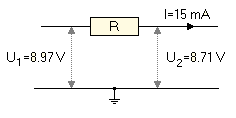| Fundamentals of Statistics contains material of various lectures and courses of H. Lohninger on statistics, data analysis and chemometrics......click here for more. |

|

Home  Basic Concepts Basic Concepts  Decimal Places and Precision Decimal Places and Precision |
|||||
| See also: standard deviation | |||||
Decimal Places and PrecisionBeginners in the field often ignore some simple facts concerning the number of significant digits of a result. The use of pocket calculators usually results in values with too many decimal places, regardless of whether this is meaningful. In general, one should use only as many decimal places as are compatible with the precision of your experiments. It may therefore be necessary to determine the precision of a measurement by repeating it several times and calculating the standard deviation.
In addition to the signal variation the accuracy of measurements may become even worse for quantities which are determined by the calculation of differences or ratios.
|
|||||
Home  Basic Concepts Basic Concepts  Decimal Places and Precision Decimal Places and Precision |
|||||


 The calculation of the electric resistance according to Ohm's law: R = U/I. In order to determine the resistance we measure the voltages U1 and U2 on both ends of the resistor. Let's assume that U1 is 8.97+/-0.01 V, U2 is 8.71+/-0.01 V, and the current I through the resistor is 0.015+/-0.001 A. From Ohm's law the resistance calculates as follows:
The calculation of the electric resistance according to Ohm's law: R = U/I. In order to determine the resistance we measure the voltages U1 and U2 on both ends of the resistor. Let's assume that U1 is 8.97+/-0.01 V, U2 is 8.71+/-0.01 V, and the current I through the resistor is 0.015+/-0.001 A. From Ohm's law the resistance calculates as follows: